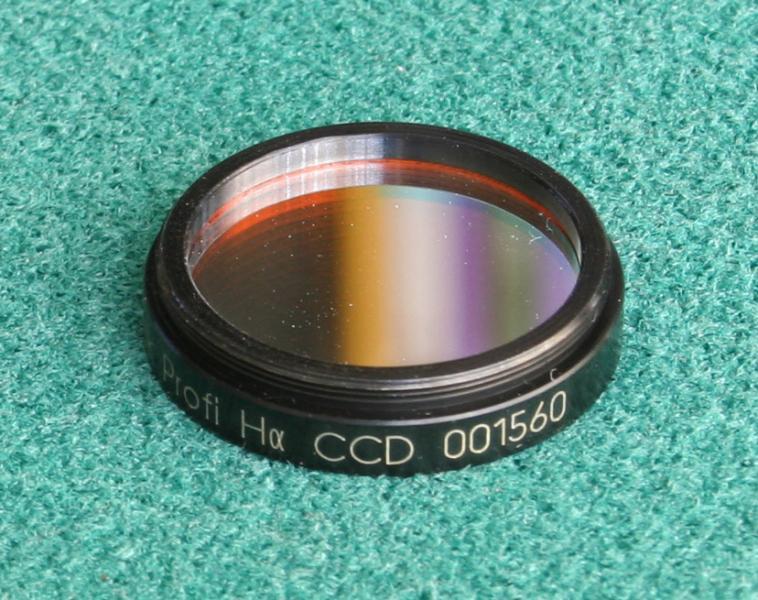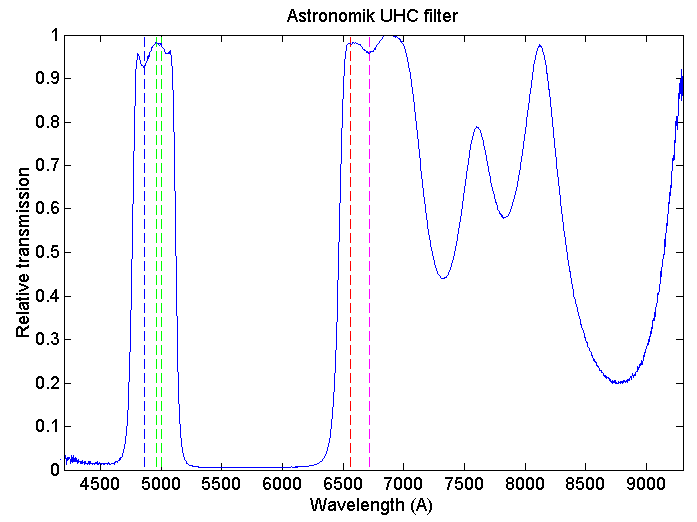A brief primer on filters
2020 October 1
Everywhere in observational astronomy, there are filters. I cannot tell you all about them in a short article, as there are so many for different purposes, even just for optical astronomy (for radio and high-energy astronomy also use filters).

Optical filters are materials that are placed in front of a detector (which could be the eye, an electronic detector, or a chemical film) or in front of the whole optical system, to allow through some wavelengths or polarisations of light and block others. Some filters – such as white-light solar filters – attempt to be neutral, attenuating all wavelengths and polarisations equally, but they can never be completely so. (I covered white-light solar filters in the February Journal.)
Envelopes & detector sensitivity
Any filter has a transmission curve that is often published by the manufacturer, or may be supplied individually with the filter. This shows the percentage of transmission at each wavelength, that is, the shape of the envelope. It is necessary always to bear in mind how this combines with the response curve of the detector. There is no point making a filter to remove wavelengths for which the detector to be used has little sensitivity. In an article in the latest E&T News (see below), Peter Anderson mentions how before he had a cataract operation, he wasn’t troubled by the violet fringes in refractors with poor chromatic correction, but having had his sight improved by the operation, now he (literally) sees the need for a filter to remove the aberration.

Another example of this is the work I have been doing to image the thermal glow of the dark hemisphere of Venus with a 990nm longpass filter. ‘Longpass’ means that the filter passes efficiently all wavelengths longer than 990nm, and has almost zero transmission below this. The objective is to capture radiation from a ‘window’ where the Venusian atmosphere is transparent, between 1,100 & 1,200nm. But it is (arguably) hardly necessary to have a filter to cut off transmission above 1,200nm, as the sensitivity of the CCD detector is so low at these wavelengths.
A further example of the application-specificity of filters is that different types will be seen on sale for visual and CCD (or CMOS) work, the latter always more expensive. Sometimes the designations ‘Type 1’ and ‘Type 2’ are used. Type 1 visual filters do not block the IR and UV wavelengths you cannot see, as there is no need for them to do so. But CCDs need either Type 2, or Type 1 plus an additional blocker. This is particularly the case when using refractors, which are never well-corrected outside the visible range.
Filter types
The filters we use for night-time observations are normally glass that is dyed, or has thin partially reflective coatings that select certain wavelengths by interference between layers.

The dyed glass filters are cheaper, but always have broad transmission curves and do not block non-visible wavelengths. They also introduce more aberrations as they are not very precisely made, and are only really used for visual observation of the Moon and planets. They can improve the apparent seeing conditions and image sharpness by reducing the effects of dispersion (different wavelengths being refracted differently by air masses) and chromatic aberration in refractors. There are many planetary applications: for example, a blue filter will darken the Great Red Spot of Jupiter, making it more obvious (though it is dark enough anyway these days), and a red filter will darken the greenish areas of Mars.
Thin-film interference filters are similar in physical principle to, but less wavelength-specific than, the solar etalons I discussed in my April article. They are more expensive and higher-quality than the dyed filters, and have more applications. Commonly ‘LRGB’ sets are used in both planetary and deep-sky imaging to take monochromatic images that can be combined into colour ones. R, G and B are red, green and blue, while L is luminance, which is the whole visible range at once. The sets need to contain uniform-thickness parfocal filters in order to avoid refocusing between colours.
The transmission curves of these filters typically look like broad humps, as do those of UV filters (useful for revealing the clouds of Venus), but interference filters can also be made with steep cut-offs: an on/off effect that is seen in the IR longpass filters useful in planetary imaging. Two steep cut-offs can also be brought close together, bracketing quite a narrow band of wavelengths. This is employed in the filters that are so useful for long-exposure imaging of nebulae that emit most of their light in narrow bands: the hydrogen alpha, oxygen III and other emission bands.
Furthermore, multiple narrow or broad transmission bands can be engineered, giving the ‘light pollution filters’ of various types that aim to pass the main nebular emissions together, but not the emissions of old-style glowing gas street lamps. Conversion to modern LED street lamps, with broadband emission, is gradually making these less useful. For a comprehensive listing of them, see E&T News Issue 1.
A further important set of filters is the Johnson–Cousins UVBRI set, used to standardise photometric measurements across detectors with differing responses.
Polarisation filters are a separate class. They look greyish, but will darken a blue sky for daytime observations, and have applications in lunar and minor planet studies. Two of them together work as a variable colour-neutral filter.
E&T News
Issue 2 of the Section newsletter was published recently, packed with equipment-related information, experiences and tips from our ever-industrious members. It may be downloaded from the Section website by logged-in members. If you would like to have future editions e-mailed to you, drop me a line at eandt@britastro.org.
David Arditti, Director, Equipment & Techniques Section
| The British Astronomical Association supports amateur astronomers around the UK and the rest of the world. Find out more about the BAA or join us. |
